AgEBB-MU CAFNR Extension
Green Horizons
Volume 24, Number 1
Winter 2020
Specialty Crops
A Missouri Family's Experience Making Maple Syrup
By John Stolwyk | Missouri Maple Syrup Initiative
Maple syrup was a major source of sugar for early Missourians, as cane sugar from the tropics was very expensive or unavailable and the beet industry of the great plains had not yet developed. Syrup, and the sugar from it, were commercially important in many rural areas. According to Missouri Bureau of Labor statistics, Missouri produced 16,317 gallons of maple syrup in 1870, 16,225 gallons in 1880, and 8,333 gallons in 1890. In addition to these amounts, large quantities of syrup were further processed into sugar. Missouri's syrup production today is only a fraction of those years and is mostly from family hobby operations such as ours.
 |
Above: drilling hole into sapwood, Below: Sap dripping from spile |
Our family taps about 200 sugar maple trees on a remote tract of land in Cole County. We collect sap over a 4-6 week period beginning in mid-January. In a typical year, we make between 15 and 25 gallons of syrup for family and friends. The process starts by drilling a 5/16" hole, about 1" to 1.5" into the sapwood of each tree. We then insert a plastic spile for directing the sap into either plastic sacks hanging on the spile, or a short tube directing sap into a plastic bucket on the ground near the tree. We transfer the sap to 4 gallon cooking oil totes for transporting with our ATV and trailer out of the woods. Our first filtration occurs at this transfer to eliminate insects and bits of tree bark. Sap that freezes in the sap sacks eventually melts and we collect it when making the rounds. Sometimes the sap partially freezes in the buckets. This is a natural method of concentrating sugar, so we can simply discard the ice disk, provided that the bucket has not frozen throughout.
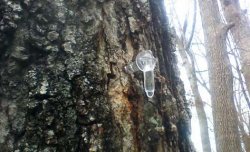 |
|
Maple sap requires some management to prevent spoilage, which can be a challenge during the highly variable Missouri winter weather conditions. Sap contains minerals, a variety of organic compounds, including up to 4% sugar, and often mold and bacteria, which could ruin the syrup. That's why it's important to store sap between 32 and 45 degrees Fahrenheit before boiling. The old adage is to treat sap like milk: if it can't be stored under these conditions, it may be best to begin boiling immediately after harvest or to freeze it. I know several Missouri syrup making families with large freezer capacity who freeze all their sap when collected. They wait for a weekend with pleasant spring weather when they can have a big overnight boil and make a social event out of the syrup making.
Our boiling site is at a farmhouse a few miles from our trees, so we have significant manual labor in lifting totes from the ATV to a truck and again onto the ground near our evaporator. However, totes give us some flexibility in sap temperature control; our totes are small enough that they can be moved into a garage to avoid freezing or warming in sunlight. I have met other Missouri syrup makers who collect their sap in large tanks and transport the tank to the boiling site on a tractor or truck. These large tanks can present a challenge in managing sap temperature.
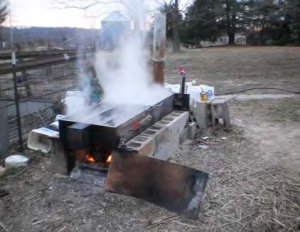 |
Boiling of sap to evaporate water |
The process of boiling is simple: evaporate as much water as quickly as we can without overcooking or scorching the syrup to concentrate the sugar and flavor compounds. Typically, to make one gallon of syrup requires 40 gallons of sap. When we have collected at least 80 gallons of sap, we boil outdoors in large stainless-steel pans. These pans rest on a temporary concrete block structure on firm ground over a wood fire, and we add sap and firewood as needed. Missouri syrupmakers use a variety of boiling equipment, from a simple evaporator with steam table trays over a wood fire to elaborate commercial evaporators with temperature monitoring instruments capable of yielding syrup right "off the fire". Most Missouri syrupmakers use firewood; some very small producers may use a turkey fryer or camp stove fueled by propane.
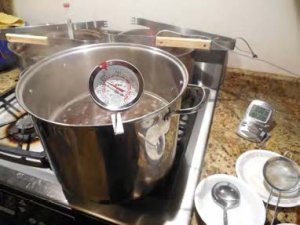 |
Sap at 'nearup' finishes boiling on the stove |
Because we don't have good temperature control over our wood fire, when we get the sap close to the desired density (when it is known as "nearup") we transfer the liquid to pots on the kitchen stove where we use digital thermometers and the hydrometer to determine when boiling is complete, which is at about 219-220 degrees F. A hydrometer is the superior method of determining syrup status; it is a calibrated device that floats in the liquid to indicate density. We also incorporate some old-timer methods of syrup-watching that confirm the instruments conclusions. We look at the type of bubbles that form on the syrup surface and how the syrup drops stretch into small "sheets" as they fall off a spoon.
The process of boiling sap generates some impurities, known as maple nitre or sugar sand. It consists of small particles of sediment and soluble compounds, that will make syrup cloudy and causes an unpleasant texture on the tongue. There are two methods of eliminating sugar sand, settling or filtration. If the syrup is allowed to cool and remain still for a few days, most of these compounds will settle out, and the clearer portion of syrup can be decanted from the storage vessel. The drawbacks of this method are that 1) a significant portion of the syrup will be left at the bottom loaded with the sand, 2) syrup can begin molding when the sand is settling, and 3) the syrup will have to be reheated before bottling. Our alternative is to filter the syrup using special filters. We use a two-fabric, conical filter where the inner portion is a pellon fabric cone with an outer wool one. As we pour freshly finished syrup into the filter, the pellon filter clogs up with sand quickly, so we remove it and place another pellon liner into the wool filter. The liquid draining out of the wool filter is beautifully clear syrup, and the solids collected in the pellon are rinsed out so that the liner can be re-used. For storage of syrup, we bottle it in canning jars while it is still above 180 degrees, and it can be stored for years in this manner.
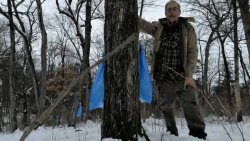 |
|
Hello! My Name is John Stolwyk
I started the Missouri Maple Syrup Initiative in 2019 as an effort to encourage more Missourians to make syrup, with the goal of eventually establishing a network or association of producers. The Initiative website address is mosyrup.com and has helpful links for syrup making beginners, suggestions for those who might want to sell syrup, and photos and profiles of several Missouri syrupmakers. Please share information about the website with anyone who has sugar maple trees or has interest in this hobby. I also want Missouri syrupmakers to be aware of the Missouri Tapping blogsite on Mapletrader.com, which is where we can share information about our syrupmaking activities and ask questions. This is a great forum for building a communication network. I look forward to working with University of Missouri Extension and the Center for Agroforestry to explore ways to increase Missouri's maple syrup production and perhaps formalizing communication among Missourians who participate in this "first harvest" each year.
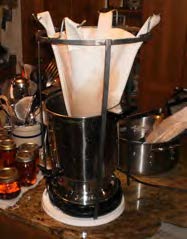 |
Left: syrup is filtered after boiling. |
 |
Right: filtered syrup stored in jars. Note the range in color due to changes in sap chemistry. As the season progresses, sap gets darker and more flavorful. |
